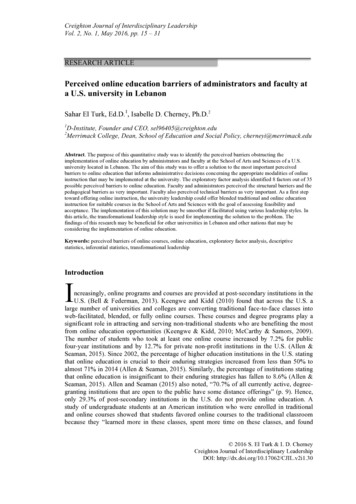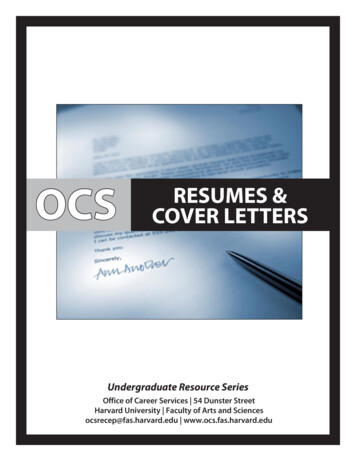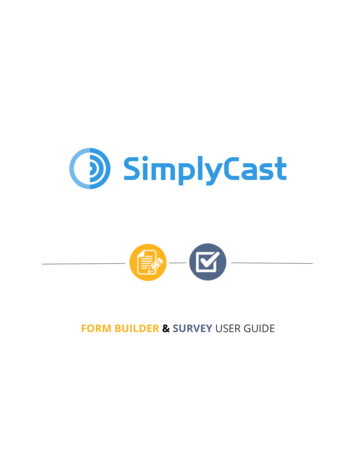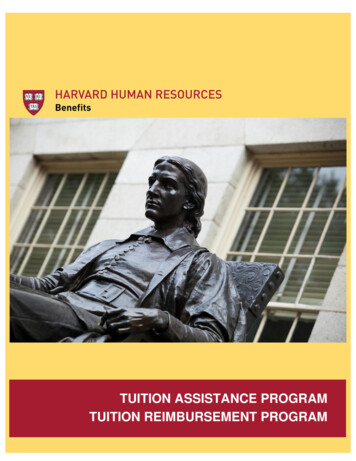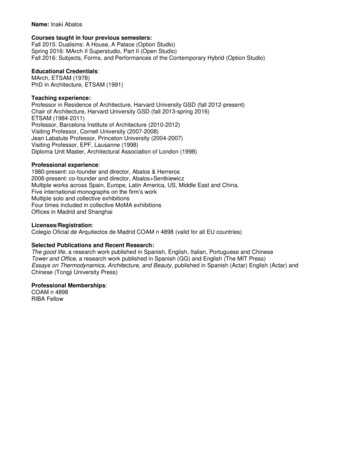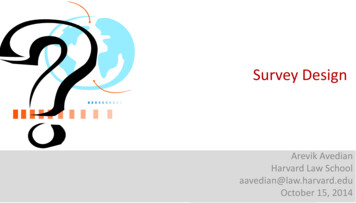
Transcription
Survey DesignSurvey DesignArevik AvedianHarvard Law Schoolaavedian@law.harvard.eduOctober 15, 2014
OverviewBasics of survey researchMeasurement levelsKey definitionsTypes of survey designsRandomization and probability sampling methodsCollecting data using computerized survey designAvoiding error and biasAssessing reliability and validityResourcesLearning QualtricsArevik AvedianSurvey Design2
Purpose of surveys A survey is a systematic method for gathering information from (a sample of) entitiesfor the purposes of constructing quantitative descriptors of the attributes of the largerpopulation of which the entities are members. Surveys are conducted to gather information that reflects population’s attitudes,behaviors, opinions and beliefs that cannot be observed directly. The success of survey research depends on how closely the answers that people give tosurvey questions match how people think and act in reality.Arevik AvedianSurvey Design3
Surveys by type of study designDesign - Planning/implementing a study– Sample survey or experiment?– How to choose people (subjects) for the study, and how many?– What questions to ask to find answers to our research questions? Descriptive – Graphical and numerical methods for summarizing (describing) the data.– Describe phenomena and summarize them. Graphs, tables and numerical summaries are all examples of descriptive statistics Inferential – Making predictions based on the data.– Inferential Statistics uses methods for making predictions about a population (total set ofsubjects of interest), based on data from a sample (subset of the population on which studycollects data). Measure associations, e.g. income and quality of life.Arevik AvedianSurvey Design4
Survey designs Cross-sectional surveys:– Data collected at one point in time selected to represent a larger population. Longitudinal surveys:– Trend: Surveys of sample population at different time points.– Cohort: Study of sample population each time data are collected but samples studiedmaybe different.– Panel: Data collection at various time points with the same sample of respondents.Arevik AvedianSurvey Design5
Questionnaire constructionQuestionnaire - a document containing questions and other types of items designed tosolicit information appropriate for analysis.– The format of a questionnaire can influence the quality of data collected.– A clear format for contingency questions is necessary to ensure that the respondentsanswer all the questions in the questionnaire.– The order of items and wording in a questionnaire can influence the responses given.– Clear instructions are important for getting appropriate responses in a questionnaire.– Questionnaires should be pretested before being administered to the study sample.Arevik AvedianSurvey Design6
Questions to think about before starting a surveyBefore designing a survey a researcher should ask:–––––––––Is this survey necessary?Is the purpose of the survey to evaluate people or programs?Can the data be obtained by other means?What level of detail is required?What type of survey is most appropriate and/or viable given funding and time (e.g.self-administered, telephone, face-to-face, or Internet)?Is the survey ethically possible?Is this a one-time survey or will the researcher repeat the survey in different settingsand/or occasions (e.g. follow-up mailing in a self-administered questionnaire, followup calls in a telephone survey)?Will the researcher have a target completion rate?How will the researcher deal with non-respondents?Arevik AvedianSurvey Design7
Guidelines for asking questions The form and meaning of questions should be appropriate to theproject. The questions must be clear and precise.– Negative terms should be avoided– Double-barreled questions (multiple questions enclosed within one) shouldbe avoided. Questions should be relevant to the respondent. Respondents must be competent and willing to answer the questions. The order and wording of questions should be set in a manner toavoid biased responses.Arevik AvedianSurvey Design8
Types of surveys Interview Surveys– Interviewers must be neutral in appearance and actions; their presence in the data-collectionprocess or personal opinion must have no effect on respondents’ choice of answers.– Interviewers must be adequately trained to be familiar with the questionnaire, to follow thequestion wording and question order exactly, and to record responses exactly as they are given.– Interviewers can use probes to elicit an elaboration on an incomplete or ambiguous response.Probes should be neutral. Ideally, all interviewers should use the same probes. Telephone Surveys– Telephone surveys can be cheaper and more efficient than face-to-face interviews, and they canpermit greater control over data collection.– Random-digit dialing (RDD) is a useful technique for eliminating potential bias in selecting numbers. Online Surveys– This method can be even cheaper than telephone and interview surveys, however must be usedwith caution because respondents may not be representative of the intended population.Arevik AvedianSurvey Design9
Methods of computerized data collectionCAPI – computer-assisted personal interviewing, in which the computer displays the questions onscreen, the interviewer reads them to the respondent and then enters the respondent’s answer.ACASI – audio computer-assisted self-interviewing, in which the respondent operates a computer,the computer displays the question on its screen and plays recordings of the questions to therespondent, who then enters his/her answers.CATI – computer-assisted telephone interviewing, which is the telephone counterpart to CAPI.IVR – interactive voice response, the telephone counterpart to ACASI, in which the computerplays recordings of the questions to respondents over the telephone who then respond by usingthe keypad of the telephone or saying their answers aloud.Web – internet surveys (e.g. Qualtrics), in which a computer administers the questions online.Arevik AvedianSurvey Design10
Privacy and ethics in survey researchResearchers should: keep confidential private information about survey participants, minimize the possibility of causing psychological discomfort or harm torespondents, when possible use paper-based, self-administered questionnaires (SAQ), insteadof face-to-face survey to elicit information of a sensitive nature.Arevik AvedianSurvey Design11
Key definitions Population: Is an entire collection of people, firms, states or things,that we are interested in, which we wish to describe, explain orpredict. Population distribution is usually unknown; we makeinferences about its characteristics such as the parameter. Sample: A sample that is representative of the population that weactually observe and is used to infer about the population. Samplevalue we find from surveys is called statistic.Arevik AvedianSurvey Design12
Sampling and inferencePopulationRandom SampleArevik AvedianSurvey Design13
Randomization and probability sampling methodsRandomization – the mechanism for achieving reliable data by reducing potential bias.Simple random sample – in a sample survey, each possible sample of size n has the same probability ofbeing selected.Systematic Random Sample – (1) selects a subject at random from the first k names in the sampling frame,and (2) selects every kth subject listed after that one. The number k is called the skip number.– Population size is N, sample size is n, k N/n.Stratified Random Sample – divides the population into separate groups, called strata, and then selects asimple random sample from each stratum.– Can be proportional (proportionate to population parameters) or disproportional.Cluster random sampling – divides the population into a large number of clusters, such as city blocks.Selects a simple random sample of the clusters. Uses all the subjects in those clusters as the sample.Multistage Sampling – uses combination of sampling methods.Arevik AvedianSurvey Design14
Sampling errorThe sampling error of a statistic equals the error that occurs when weuse a sample statistic to predict the value of a population parameter.– Ex. Random survey is estimating percentage of US population favoring Obama before theelections. If the survey estimated 54 and the actual rating was 59%, the sampling error wouldequal 5%.Note: In practice the true sampling error is unknown, because the population parameters are unknown.Randomization protects against bias; direction and extent of bias isunknown for studies that cannot employ randomization.– Major polling organizations predict outcomes with 3% accuracy (margin of error) when n isabout 1000.Arevik AvedianSurvey Design15
Sampling variability and possible biasOther factors besides sampling error can cause results to vary from sample to sample: Sampling bias (nonprobability sampling, undercoverage)– Volunteer sampling Response bias (e.g., poorly worded questions, order of questions, approval of theinterviewer)During the Cold War a study asked: “Do you think the US should let Russian newspaper reporters come here and send backwhat ever they want?” and “Do you think Russia should let American newspaper reporters come in and send back whateverthey want?” The percentage of yes responses to the first question increased from 36% to 73% when asked second (“TaintedTruth: The Manipulation of Fact in America,” Crossen, 1994). Nonresponse bias (missing data, respondents can’t be reached or refuse to participate)– Results of any sample with over 20% nonresponse rate should be questionable.Arevik AvedianSurvey Design16
Results of surveys may depend greatly on wordingex. 2006 New York Times poll:“Do you favor a gasoline tax?”12% yes“Do you favor a gasoline tax- to reduce U.S. dependence onforeign oil?” 55% yes- to reduce global warming?” /20060228 poll results.pdfArevik AvedianSurvey Design17
Why a random sample?The case of the 1936 Literary Digest Poll The presidential election of 1936 pitted Alfred Landon, the Republican governor of Kansas, against theincumbent President, Franklin D. Roosevelt.The year 1936 marked the end of the Great Depression, and economic issues such as unemployment andgovernment spending were the dominant themes of the campaign. The Literary Digest magazine mailed a questionnaire to 10 million people (2.3 million replied) just beforethe presidential election.It was based on every telephone directory in the United States, lists of magazine subscribers, rosters of clubs andassociations, etc.The prediction was that Landon would get 57% of the vote against Roosevelt's 43% (these arethe statistics that the poll measured).Arevik AvedianSurvey Design18
Who won?The actual results of the election were 61% for Roosevelt against 37% for Landon (these werethe parameters the poll was trying to measure). Gallup American Institute of Public Opinion achieved national recognition by correctly predictingthe result of the election within about 1%, using a much smaller sample size of 50,000.Arevik AvedianSurvey Design19
What went wrong with the polls?There were two basic causes of the Literary Digest's downfall: selectionbias and nonresponse bias.The first major problem with the poll was in the nonrandom selectionprocess for the names on the mailing list, which were taken fromtelephone directories, club membership lists, lists of magazinesubscribers, etc.– Such a list was guaranteed to be slanted toward middle- and upper-classvoters in 1936, and by default to exclude lower-income voters.The second problem was that out of the 10 million people whose nameswere on the original mailing list, only about 2.4 million responded to thesurvey (that’s a 76% nonresponse rate!).– People who respond to surveys are different from people who don't, notonly in the obvious way (their attitude toward surveys) but also in moresubtle and significant ways.Arevik AvedianSurvey Design20
Validity and reliability of survey measuresReliability: Whether the measure will produce a similar value when themeasuring instrument is reapplied.External validity: Whether (causal) relationships can be generalized to differentmeasures, persons, settings, and times.Internal Validity: Whether the effects observed in a study are due to theindependent variable of interest and not some other “confounding” factor.Arevik AvedianSurvey Design21
Types of survey question formats Open-ended question: Questions for which the respondent is askedto provide his or her own answers. In-depth, qualitative interviewingrelies almost exclusively on open ended questions.– Disadvantage of open-ended questions is more complex data analysis. Closed-ended question: Survey questions in which the respondent isasked to select an answer from among a list provided by theresearcher.– Popular in survey research because they provide a greater uniformity ofresponses and are more easily processed than open-ended questions.Arevik AvedianSurvey Design22
Open-ended questionsOpen-ended question formats provide a Examples of open-ended questions:blank space or box where respondentstype or write in their response using their Have you ever made an error in judgmentown words (or numbers).that you had to address with youremployer? How did you handle it?Pros: Some information that researchers areseeking may be impossible to obtainwith closed-ended questions and are When you are under a lot of stress, what isrevealed through open-ended format your typical reaction?questions.Cons: Coding the answers for statisticalanalysis.Arevik AvedianSurvey Design23
Closed-ended questionsClosed-ended question formats or scalar questionsprovide respondents with a list of answer choices fromwhich they must choose to answer the question.Types of closed-ended answers: Interval scale questions provide answers thatpossess the properties of order and constant units ofdistance.– E.g. age, income Ordinal scale questions provide answers withordered categories (difference between thecategories is not the same).– E.g. intensity of opinion or pain, frequency of events orbehaviors Nominal scale questions provide answers withcategories that are unranked and unordered.Nominal scale does not possess order, distance, ororigin.– E.g. Ethnicity, color of hair, select all that applyArevik AvedianInterval:Here is a scale of incomes. We would like to know in what group yourhousehold is, counting all wages, pensions and other incomes that come in. Up to 20,00020 001 to 40,00040,001 to 60,00060,001 to 80,00080,001 to 100,000100,001 or moreOrdinal:How likely are you to vote for Obama in the November 2012 Presidentialelection? Not likely at allSomewhat likelyVery likelyNominal:For which major candidate do you plan to vote in the November 2012Presidential election? ObamaRomneyOtherI will not voteSurvey Design24
Mixed-method (combines open & closed formats)EMPLOYEE BENEFITS SURVEYStatementHealth BenefitsI am satisfied with my health plan options.I am satisfied with my dental plan options.I am satisfied with my vision plan options.I am satisfied with my long-term disability insurance.I am satisfied with my short-term disability insurance.I am satisfied with my options for life insurance.Overall, I am satisfied with my health benefits.Financial BenefitsI am satisfied with my retirement plan.I am satisfied with my salary.I am satisfied with the Employee Stock Purchase Program.I am satisfied with my opportunities for promotion, raises, and bonuses.Overall, I am satisfied with my financial benefits.Paid Time OffI am satisfied with the number of vacation, sick, and personal days that I receive.Overall, I am satisfied with my paid time off.OverallI understand my benefit options.I know where to find information about my benefits.I know whom to call if I have questions about my benefits.Overall, I am satisfied with my employee benefits.Additional Comments:Arevik AvedianStrongly AgreeAgreeSurvey DesignNeutralDisagreeStrongly Disagree25
Make questions clearQuestionnaire items should be precise so that the respondent knows exactly what the researcher is asking. What was your income last week? What was your income for the entireperiod of 10/01/14 to 10/08/14?– Respondent may only considerweekdays, while researcher means fullweek. Are you employed full time?– Respondent may not know exactlywhat is considered full time for theresearcher.Arevik Avedian Are you employed at least 35 hours aweek?Survey Design26
Avoid double-barrel questionsAvoid asking for a single answer to a question that actually has multiple parts. As a general rule, wheneverthe word and appears in a question check whether you are asking a double-barreled question. The United States shouldwithdraw from Afghanistan andspend the money on domesticprograms.– While many respondents wouldunequivocally agree with thestatement and others wouldunequivocally disagree, some may beunable to answer, as they agree onlywith one part of the question.Arevik Avedian In your opinion, should the USwithdraw from Afghanistan? Would you like the US to spend moremoney on domestic programs?Survey Design27
Short questions are bestRespondent should be able to read a question quickly, understand its intent and select or provide an answerwithout difficulty. In general, assume that respondents will read questions quickly and give quick answers. Example from a survey conducted byHarris Poll in 1986:– “If Libya now increases its terrorist actsagainst the US and we keep inflicting moredamage on Libya, then inevitably it will allend in the US going to war and finallyinvading that country which would bewrong.”Arevik AvedianRespondents were given the opportunity ofanswering “Agree,” “Disagree,” or “Notsure” with the following statements:– 1. Will Libya increase its terrorist actsagainst the U.S.?– 2. Will the U.S. inflict more damage onLibya?– 3. Will the U.S. inevitably or otherwise goto war against Libya?– 4. Would the U.S. invade Libya?– 5. Would that be right or wrong?Survey Design28
Avoid negative and double negative questionsNegation in a question paves the way for easy misinterpretation. Negative words to avoid are “not”, “prohibit”,“impossible,” etc. Double-negative questions often make it unclear for respondents whether to put a “yes” or “no.” PhD students should not be required totake qualifying exams to graduate. Should PhD students be required to takequalifying exams to graduate? An actual example of double negative: After correcting the double negative:– Would you favor or oppose a bill thatwould prevent any foreign-ownedcompany from owning cargo operations atseaports in the United States? (Gallup,March 10-11, 2006) 58% opposedArevik Avedian– Would you favor or oppose a bill that wouldallow only U.S. companies to own cargooperations at seaports in the UnitedStates? (Gallup, March 13-16) 25% opposedSurvey Design29
Target the vocabulary of the population to be surveyed For studies within a specific organization, use the jargon used in that organization.Be careful not to use language that may not be familiar to the respondents.Avoid unnecessary abbreviations.Use simple words.Avoid biased items and terms.– Rasinski (1989) analyzed several General Social Survey (GSS) studies and found that theway programs were identified had an impact on the amount of public support theyreceived: Here are some of the comparisons:More support“Assistance to the poor”“Dealing with drug addiction”“Improving conditions of blacks”“Protecting social security”Arevik AvedianLess support“Welfare”“Drug rehabilitation”“Assistance to blacks”“Social security”Survey Design30
Describing surveys - Example 1: SOCSurvey NameSponsorCollectorPurposeSurvey of Consumers (SOC)University of MichiganSurvey Research Center, University of MichiganMain objectives are to: Measure changes in consumer attitudes and expectations Understand why such changes occur Evaluate how they relate to consumer decisions to save, borrow, or make discretionary changesYear StartedTarget Population1946Noninstitutionalized adults in the coterminous United States (excludes Hawaii and Alaska)Sampling FrameCoterminous US telephone households, through lists of working area codes and exchangesSampling DesignSample SizeUse of InterviewerMode of AdministrationComputer AssistanceReporting UnitTime DimensionFrequencyInterviews per Round of SurveyList-assisted random-digit dial sample, randomly selected adults500 adultsInterviewer administeredTelephone InterviewComputer-assisted telephone interviewing (CATI)Randomly selected adultTwo-wave panel of personsConducted monthlyTwo: reiniterview conducted six months after initial interview subset of wave 1 respondentsLevels of ObservationWeb LinkPersonhttp://sca.isr.umich.eduSource: Survey Methodology, Groves et al.Arevik AvedianSurvey Design31
Describing surveys - Example 2: NSDUHSurvey NameSponsorNational Survey of Drug Use and Health (NSDUH)Substance Abuse and Mental Health Services Administration (SAMHSA)CollectorPurposeRTI InternationalMain objectives are to: Provide estimates of rates of use, number of users, and other measures related to illicit drug, alcohol, and tobacco use at the stateand national level Improve the nation’s understanding of substance abuse Measure the nation’s progress in reducing substance abuseYear StartedTarget PopulationSampling Frame1971 (formerly names National Household Survey on Drug Abuse)Noninstitutionalized population of the United States aged 12 years or olderU.S. households, enumerated through U.S. counties, blocks and list of members of the householdsSampling DesignMultistage, stratified clustered area probability sample within each state.Sample SizeUse of Interviewer141,487 housing units; 67870 persons (2007 NSDUH)Interviewer administered, with some self-administered questionnaire sections for sensitive questionsMode of AdministrationFace-to-face interview in respondent’s home, with portions completed by respondent aloneComputer AssistanceComputer-assisted telephone interview (CATI), with audio computer-assisted self-interview by respondent aloneReporting UnitEach person age 12 or older in household reports for self. Respondents may allow more knowledgeable family member to completeHealth Insurance and Income sections of survey for them.Repeated cross-sectional surveyConducted annuallyOnePerson, householdhttp://www.samsha.govTime DimensionFrequencyInterviews per Round of SurveyLevels of ObservationWeb LinkSource: Survey Methodology, Groves et al.Arevik AvedianSurvey Design32
Recommended readingsBabbie, E. R. (2009) The Practice of Social Research (12th Edition). Belmont, CA: WadsworthPublishing. ISBN-13: 9780495598411Dillman, D.A., Smyth, J.D., & Christian, L.M. (2008) Internet, Mail, and Mixed-ModeSurveys: The Tailored Design Method (3rd Edition). Hoboken, N.J.: Wiley & Sons.ISBN-13: 978-0-471-69868-5Groves, R.M., Fowler, F.J. Jr., Couper, M.P., Lepkowski,J.M., Singer, E., Tourangeau, R. (2009) SurveyMethodology (2nd Edition). Hoboken, N.J.: Wiley & SonsISBN-13: 978-0-470-46546-2Arevik AvedianSurvey Design33
Working with Qualtricsharvard.qualtrics.comSupportFor resources, including training and documentation, please visit the Qualtrics webpage atwww.qualtrics.com/university/researchsuite/Learn Qualtrics in 5 Steps at: Five step training programSurvey Design34
Oct 15, 2014 · Online Surveys – This method can be even cheaper than telephone and interview surveys, however must be used with caution because respondents may not be representative of the intended population. Arevik Avedian 9 . Survey Design



